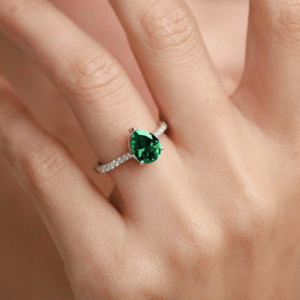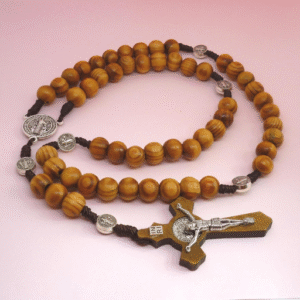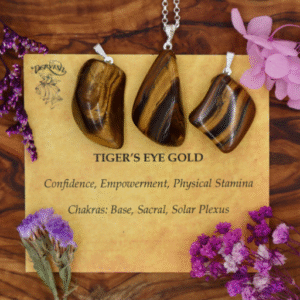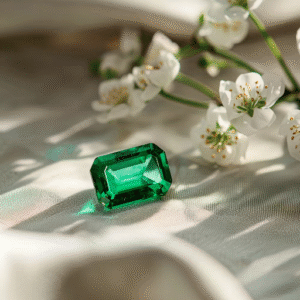More than just an arrangement of beads, the rosary is a spiritual instrument, rich with inception, tradition, and significance, used over centuries for aiding prayer and reflection. For many, rosary beads offer a physical manifestation of their faith, acting as a traditional means of contemplating the sacred mysteries of life and inducing tranquility and concentration. In this article, the complex nature of a rosary bead will be uncovered, along with its symbolism, and we’ll briefly draw upon global practices embedding these beads in spiritual rituals. The guide will prove useful as it sheds light on the reasons behind an age-old significance of the rosary for anyone acquainted with or unfamiliar with it.
The Structure of a Rosary

The rosary is actually a set of prayer beads that aid in prayer and meditation, mostly in Christian traditions. It consists first of a crucifix amounting to a prayer sign, then followed by larger and smaller beads. The bigger beads mark the beginning of particular prayers, while the smaller ones count repetitive prayers, such as the Hail Mary. There are usually five groups called decades, each representing a mystery of faith. The straightforward arrangement helps keep the mind focused on prayer, inculcating systematic reflection in spirituality.
Components of a Rosary Bead
This article has discussed how rosary beads are designed to aid a meditative prayer practice. These are the core parts of a rosary bead, along with an explanation of their significance:
Crucifix
The rosary begins with a crucifix, symbolizing the fundamental belief in the life, death, and resurrection of Jesus Christ. Usually made of metal or wood, the crucifix serves to remind the devotee of Christ’s sacrifice and serves as the base upon which they begin their prayers.
Opening Bead
It is after the crucifix that one single larger bead follows, used to recite the Apostles’ Creed, a prayer stating the very root beliefs of Christianity, serving as a kind of charity for the contemplative prayer sequence.
Set of Small Beads (Hail Mary Beads)
From the opening bead, these start with three smaller beads traditionally used to pray the Hail Mary. They are for the three theological virtues: faith, hope, and charity.
Centerpiece (Connector Medal)
The midpoint of the rosary is marked by a centerpiece, usually considered a medal with an image of the Virgin Mary, a saint, or another religious symbol. This piece bridges the string of beads that continues in a loop and symbolizes unity and devotion to Mary as the mother of Jesus.
Decades
Normally, five decades make up a rosary, each comprising a large bead followed by ten small beads. Each decade is set apart for a specific mystery describing major events of Christ’s life or of the Virgin Mary’s participation in salvation. The prayers on these beads alternate between the Lord’s Prayer (Our Father) on the large bead and ten Hail Marys on the small beads. A Glory Be prayer is said to conclude each decade.
Mysteries of the Rosary
These mysteries split into four series—Joyful, Sorrowful, Glorious, and Luminous (the latter added by Pope John Paul II in 2002). The mysteries focus meditation themes, heightening meditative states, and shifting by the day of the week.
Joyful Mysteries (e.g., Annunciation, Nativity)
Sorrowful Mysteries (e.g., Crucifixion, Agony in the Garden)
Glorious Mysteries (e.g., Resurrection, Assumption of Mary)
Luminous Mysteries (e.g., Baptism of Jesus, Institution of the Eucharist)
Material and Operation Details
Rosaries can be constructed out of wood, glass, crystal, or metal. Some rosaries contain hand-sewn gemstones, making them not just sacred objects but very cherished keepsakes. The design and material are a result of the tradition and cultural background of the user or simply his/her personal preference.
The modern rosaries may also be in digital app formats so one can use them conveniently; however, the understood commonness of bead type still happens to have a very worthy touch and symbolic nature of use.
How Many Beads Are There on a Catholic Rosary?
The traditional Catholic rosary consists of 59 beads. The beads are arranged into five sets of ten smaller beads, called a decade. These smaller beads are used for praying “Hail Mary.” Between the decades runs a bigger bead, upon which an “Our Father” is said. Between this larger bead and the crucifix lies a centerpiece that connects the three smaller beads and one larger bead that are for the introductory prayers, including the “Apostles’ Creed,” “Our Father,” three “Hail Marys,” and the “Glory Be.”
Although this is the most common arrangement, it is not the only configuration. Some chaplets or smaller rosaries may have fewer beads depending on the specific devotion or purpose they represent. However, what is considered a standard rosary with 59 beads guides devotees in the traditional prayers and meditations of the Catholic practice.
Arrangement of Beads in a Rosary
The bead arrangement in the rosary is carefully meant to assist prayer and meditation. A classic rosary consists of 59 beads, divided into several smaller groups. Among these are five ten-bead groups, called the “decades.” Each decade is separated from the next by a single bead on which the prayer “Our Father” is recited. The smaller beads in a decade guide the praying of ten “Hail Marys” as the person meditates on one of the chosen “Mysteries” of the Rosary.
Starting with more beads, the rosary prays introductory prayers: one large bead for one “Our Father,” three small beads for three “Hail Marys,” and one bead for the “Glory Be.” They are generally considered preparatory for the encapsulated form of meditation called the rosary.
Also, a crucifix is positioned at the beginning of the rosary, symbolizing Christ’s suffering. The glorification of Christ starts the rosary with the “Sign of the Cross” and the “Apostles’ Creed,” grasping the crucifix as a point of spiritual departure. The connecting chain or cord of the beads is usually configured into a loop, the concept behind ease of repetition of all prayers.
Chaplets, for example, are small-scale rosary alternatives for particular devotions. The Divine Mercy Chaplet includes an arrangement developed expressly for reciting the “Divine Mercy” devotion. While their actual configuration may differ somewhat, the common factor is their use as a guide for systematic and heartfelt prayer.
Historical Context of Rosary Beads

In tracing the history of rosary beads, there is often an appeal to early Christian traditions in which prayers were counted through stones or knotted strings. By Medieval times, the more structured use of the rosary for devotion to Mary had spread widely, with the order of the Dominicans largely responsible for the promotion. The actual setting of keys-numbered decades with one Our Father followed by ten Hail Marys–and mysteries concerning main events in the life of Jesus and Mary developed through evolutions in the practice over time, having reached formal crystallization by the 15th century. More or less by extension, the rosary has since remained the foremost medial devotion in the Catholic Church, representing meditation, reflection, and an emphatic link toward one’s faith.
Origins of the Rosary
Trying to discover the beginning of the rosary, one must look into early Christian prayer traditions where repetitive prayers helped meditation and supplication. Early Christians would put to use pebbles, or knotted cords, and these could be considered an ancestor to the bead system that comes to mind today with the rosary. Through the years, “Hail Marys” began to take a central place in such devotional prayers.
The structured form of the rosary as nowadays known was developed in the 12th and 13th centuries. It is largely influenced by Saint Dominic, who is said to have popularized the rosary reflections as a potent spiritual tool. Members of the Dominican Order worked hard to standardize the practice by instituting reflection on what are now called the “mysteries,” events in the life of Jesus and Mary categorized as Joyful, Sorrowful, and Glorious, with the Luminous mysteries added by Pope John Paul II in 2002.
According to this research and data, the rosary is still an essential part of Catholic devotion nowadays, with a revival happening in the younger generations. Different Catholic organizations and Internet platforms report an increase in rosary prayer groups and technological facilities like mobile apps that help users navigate through the process of praying. This interweaving of tradition and technology testifies to the continuing importance of the rosary as an anchor of spirituality for the faithful.
Evolution of Prayer Beads Across Cultures
Prayer beads, common in spirituality worldwide, are deemed to affect devotion, meditation, or mindfulness. Besides Christian rosaries, different cultures have, through the centuries, had their own versions of prayer beads with variations in construction or function. For example, Hindus and Buddhists use “malas” of usually 108 beads to chant mantras or prayers (japa). Repetition through the beads is used as a form of meditation-cum-interaction between body, mind, and spirit.
However, in Islam, prayer beads called “misbaha” or “tasbih” normally include 33 or 99 beads, which correspond with the names of Allah recited during prayers. Similarly in Sikhism, beads or “gutkas” are used in meditative recitations of the divine name, adding even more to their spiritual necessity.
The modifications of prayer beads have also been subjected to influences from modern technology. Today we have digital versions comprising certain applications and virtual representations of the real thing. Statistically, a newer trend analysis highlighted an increased global interest in prayer beads, wherein searches with terms like “spiritual beads” and “meditation beads” rose by roughly 25% in the last two years, as per search data. This points to an increased emphasis on mindfulness and spirituality all over the world, going beyond the limitations of religious certainties.
The uninhibited variety of prayer bead traditions speaks both of their depth of connecting people with the Divine and comforting them in their needs, while the modernizing of such traditions points to their relevance in today’s digitized world.
Significance in Catholic Tradition
Prayer beads have always been a symbol—perhaps once thought of in some fashion as a road to meditative prayer and reflection within Catholicism. While the rosary is an ancient and integral part of Catholic worship, it is said to invoke the Virgin Mary, contemplate the mysteries of Christ, and seek calming peace. The very design of the rosary guides the devotee through certain prayers to enhance their focus on faith and devotion.
According to recent Google Search data, the world has seemingly opened with renewed interest in some of the older expressions of faith, such as the Catholic rosary. Search queries with the terms “Catholic rosary,” “how to pray the rosary,” and “rosary mysteries” have almost jumped 30% since five years ago the world-wide over-half of which may well be attributed to modern-day individuals who are increasingly leaning towards spiritual pursuits for mindfulness and mental clarity. A further facet of growing curiosity remains under the nontraditional rosaries, such as those featuring modern design language or versatile materials, which appeal to the younger generation without compromising their central spiritual functions.
By remaining dormant for some centuries and then suddenly sprouting a flowering adaptation, prayer beads remain in deep resonance in the lives of seekers looking for solace, guidance, and intimacy with God, creeping alongside the humming impatience of this ever-accelerating world.
Spiritual Meaning of Rosary Beads
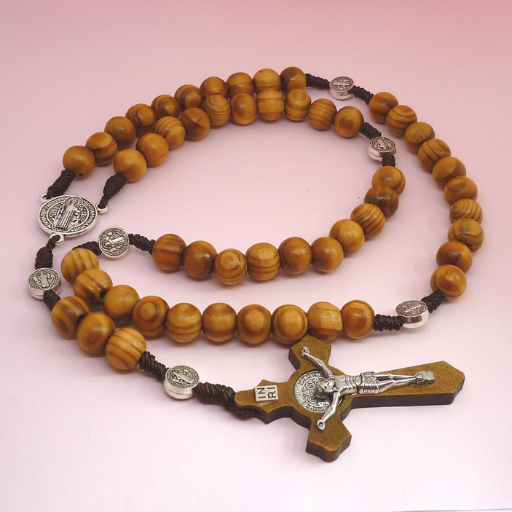
The spiritual meaning of rosary beads can be interpreted as a tool for prayer, meditation, and reflection. While the beads guide one to focus their thoughts and strengthen their faith by saying prayers like the Hail Mary or the Our Father, each bead represents a single prayer and generates a rhythm for concentration and devotion. The act of praying with the beads deepens the relationship between the person and God while also delivering solace, peace, and spiritual guidance.
Prayer and Meditation with Rosary Beads
The use of rosary beads in praying or meditating is an ancient custom that provides personal spiritual comfort and set worship. Each segment of the rosary corresponds to certain mysteries that relate to the life of Jesus and Mary for the contemplation of the faithful. According to current estimates, millions of people all over the globe say rosary prayers each day, signifying its global appeal and ability to focus the prayers.
Studies show that repetitive prayers similar and parallel to the rosary can reduce stress, decrease blood pressure, and bring a surprising feeling of internal peace. Studies also point out that meditative practices enabled by the use of the rosary set in motion the parasympathetic system, increasing mental clarity and emotional wellness. Evolving and undergoing further changes is the spirituality of praying the rosary, with digital rosary applications now allowing for engagement anywhere and anytime. Such technological advances have established a place for the rosary in today’s fast-paced century while maintaining its historic and spiritual significance.
Symbolism Behind the Number of Beads
The number of beads on a rosary enjoys profound symbolism linked to different facets of faith and devotion. Typically, a regular-sized rosary comprises 59 beads, broken into sets of 10 called “decades.” Each decade signifies one particular mystery of faith: Joyful, Sorrowful, Glorious, or Luminous, with larger beads reserved to separate the transition between one mystery from another.
Ten smaller beads denote the ten Hail Marys recited in meditation to the Virgin Mary. Five larger beads mark the “Our Father” prayers meant to meditate on key moments of Christ-Jesus’s life. Sometimes, the crucifix is attached as an integral part of the rosary, stressing Christ and His sacrifice-the central theme.
Historically, from its early Christian beginnings, the string of beads method of counting prayers was likely developed under the influence of other religions. The number thus holds dual pragmatic and spiritual values, counterbalancing prayer to establish rhythm and focus.
There are some modern-day adaptations of the rosary, one of which includes one-decade chaplets, allowing people to exercise their own spirituality according to lifestyles while keeping their symbolic status intact, thereby ensuring the continued relevance of this ancient prayer practice across cultures and contexts.
Sources from theological studies and religious historians recommend that the design and layout of the rosary are thoroughly thought out so as to offer not just a physical guide in praying but a deep symbolic framework. The timeless ritual guides present-day spiritual practice informed by past tradition.
Meaning of Colors in Rosary Beads
The colors of rosary beads are not simply anything of beauty; they often carry tremendously symbolic meaning that can somehow uplift the prayer experience. Each color bears a different significance whereby an individual may feel free to interpret and relate to faith and devotion. Following are some of the widely used rosary colors and their corresponding accepted meanings:
Black Rosary Beads: The color black calls to remembrance strength, sacrifice, and in some cases, mourning. One may witness the use of black rosaries in circumstances of grief or during prayers of penitence. They thus connect sorry reflections on humanity with the fortitude that comes through faith.
White Rosary Beads: White beads possess symbolism of purity, virtue, and spiritual renewal. They are more likely to be chosen in baptisms or in prayers asking for divine guidance and clear paths ahead.
Blue Rosary Beads: Blue encourages a feeling of peace, protection, and association with the Virgin Mary. Blue rosaries are often used while praying for healing, peace, and protection against evil.
Red Rosary Beads: Red rosary beads represent the blood of Christ-the symbol of love and sacrifice and are usually associated with prayers of fervor, commitment, and remembrance of Christ’s ultimate sacrifice for mankind.
Green Rosary Beads: Green signifies completion, hope, and renewal. Such beads associate with prayers seeking change in self, prosperity, or healing.
Purple Rosary Beads: Purple indicates penitence, reflection, and preparation. It is ordinarily worn or carried in periods such as Lent and Advent. These beads focus on spiritual growth whenever one sets out to ask for forgiveness.
Yellow or Gold Rosary Beads: These colors suggest joy, wisdom, and light; they are respectively associated with prayers of gratitude and thanksgiving, as reminders of the glory of God.
Pink Rosary Beads: Pink symbolizes love, compassion, and comfort. It is utilized in prayers of thanksgiving and devotion and during exciting celebratory occasions.
Contemporary rosary manufacturers hold individual preferences as constraints and open the way for beads with blended colors, crystals, or uniquely decorative designs to allow one to relish a deeply personal association with the rosary. The traditional meaning surely still holds true, and recent trends strongly indicate that rosary beads of any given color should stand to represent fashion, function, and faith in their own right.
Using Rosary Beads in Practice

Praying with the rosary is a meditative process: the person will begin by holding the crucifix, making the Sign of the Cross, and reciting the Apostles’ Creed. One moves through each bead, praying for each bead the corresponding prayers: Our Father, Hail Mary, Glory Be, and so forth. The beads are actually devices to help overtly or consciously say prayers and to distract from others, maintaining meditation affirmations; their rhythms become grounds on which the mind contemplates deeply. Thus, rosary beads can be used in solitude or in groups: a private or communal spiritual activity.
How to Pray the Rosary
Praying the Rosary is an ancient devotion that lends itself well to meditation and connecting with the life of Christ and the Virgin Mary. A step-by-step guide to the Rosary follows, with details to deepen your understanding and practice.
Start by Blessing Yourself
Holding the crucifix, bless yourself with the Sign of the Cross while reciting the Apostles’ Creed, which professes one’s acceptance of our faith.
The First Bead: Our Father
Honor God on this lonely bead just after the crucifix. Recite the Our Father (or the Lord’s Prayer) aloud, particularly focusing your intention on it.
The Three Hail Marys
Say three Hail Marys, one on each bead of the next three beads. They are asked for the virtues of faith, hope, and charity. Conclude this section by saying Glory Be to the Father, the brief doxology.
The First Mystery
Depending on the day of the week, meditate on the first mystery: Joyful, Sorrowful, Glorious, or Luminous Mysteries. Example:
On Mondays and Saturdays, the Joyful Mysteries are highlighted, the events such as the Annunciation and the birth of Jesus.
Thursdays instead concentrate on the Luminous Mysteries; that is, the key moments in Christ’s public ministry.
After the mystery has been announced, pray the Our Father on the single bead and begin meditating upon the mystery.
The Decade of Hail Marys
While meditating on the mystery, pray the ten Hail Marys, one for each bead in the decade. Try to keep your mind clear by thinking about the events and what you can learn from them.
After Each Decade, Pray the Glory Be and Perhaps the Fatima Prayer
After each decade, say the Glory Be followed by the Fatima Prayer:
“O my Jesus, forgive us our sins, save us from the fires of hell, lead all souls to Heaven, especially those in most need of Thy mercy.”
For all the Other Mysteries
Continue in this manner with all five mysteries. Follow the traditional rotation daily.
Conclusion Prayers
After the Rosary, say the Hail Holy Queen followed by the concluding prayer:
“O God, whose Only Begotten Son, by His life, death, and resurrection, has purchased for us the rewards of eternal life; grant, we beseech Thee, that while meditating upon these mysteries of the most holy Rosary of the Blessed Virgin Mary, we may imitate what they contain and obtain what they promise, through the same Christ our Lord. Amen.”
End Finally with the Sign of the Cross.
Additional Tips and Data
Rosary Apps and Websites
Such modern tools as the Rosary prayer apps or websites provide you with guided meditation, audio Rosaries, and daily reminders of the mysteries-even making it easier to add the Rosary to your life.
Symbolism of Numbers
The construction of the Rosary abounds in symbolism. To recite 50 Hail Marys (divided into five decades) is a sign of affection and meditative repetition.
Health Benefits
Research indicates that prayer and meditation, such as the Rosary, can help reduce stress, lower blood pressure, and promote a feeling of peace and well-being way of integrating spirituality and mental health.
In its essence, the Rosary is an ageless tool through which one converses with the Divine and finds peace when faced with worldly challenges. Either in private or communal use, these prayers earnestly endow life with meaning and grace for citizens around the world.
Mysteries of the Rosary: An Overview
The Mysteries of the Rosary stand at the core of this particular prayer, designed to enable the faithful to meditate upon important events in the lives of Our Lord Jesus Christ and His Most Holy Mother. These Mysteries are grouped into four different series of five events each, commonly referred to as the Joyful, Sorrowful, Glorious, and Luminous Mysteries. Each series is intended for a different set of thematic reflections to be performed on various days of the week.
The Joyful Mysteries
The traditional days of saying the Joyful Mysteries are Mondays and Saturdays; hence, the Joyful Mysteries meditate upon the Incarnation and early life of Jesus. They are the Annunciation, the Visitation, the Nativity, the Presentation of Jesus in the Temple, and the Finding of Jesus in the Temple. Each one resonates with the joy and hope that comes through the fulfillment of God’s promise.
The Sorrowful Mysteries
These Mysteries, prayed on Tuesdays and Fridays, focus on the passion, sacrifice, and redemption of Jesus Christ. The five instances are the Agony in the Garden, the Scourging at the Pillar, the Crowning with Thorns, the Carrying of the Cross, and the Crucifixion and Death of Jesus.
The Glorious Mysteries
The Glorious Mysteries are said on Wednesdays and Sundays, celebrating the final triumphs and victories of Christ and Mary – the Resurrection, the Ascension, the Descent of the Holy Spirit, the Assumption of Mary, and the Coronation of the Blessed Virgin.
The Luminous Mysteries
Introduced by Pope John Paul II in 2002, the Luminous Mysteries are said on Thursdays and focus on the public ministry of Jesus. They include the baptism of Jesus, the wedding at Cana, the proclamation of the kingdom of God, the transfiguration, and the institution of the Eucharist.
Each Mystery acts as a spiritual viewing glass with which the faithful can connect to their belief system and meditate upon the teachings of Christ in preparation for living out their lives. Research shows that meditative praying can increase awareness, have an anxiety-reducing effect, and promote well-being and inner peace, which is a great testimony to the practicality of the prayer.
Hence, through praying these Mysteries in an orderly fashion, the Rosary remains an intensive spiritual practice that resonates with millions today.
Making Your Own Rosary Beads
Handmaking your rosary beads can be a rewarding, personal experience that allows an individual to create their prayer and meditation tool. The materials required would be beads of your choice (commonly 59 beads for a full rosary), a strong string or wire, a crucifix, and spacers or small beads to mark important sections. Depending on their liking and spiritual attributes, many prefer using wood, glass, or gemstone beads.
The first step is to decide on the lay-out of the rosary, which consists of five decades (sets of ten beads) separated by single beads for prayers such as the “Our Father”. It is advisable to knot between beads or use crimp beads for added strength, especially when the rosary is often handled. Therefore, depending on the bead size, planning and measurement need to be carried out ahead of time in regards to wire or string length.
Special charms or uniquely colored beads are options that might add personal meaning to a rosary design, especially for someone who celebrates the individuality of these items. Colors may be interpreted as representing spiritual purposes; particular stones, for example, amethyst or jasper, are said to convey calmness and protection.
It is interesting that making one’s own rosary also offers a meditative experience of reflection and intention-setting while stringing the beads. There are innumerable tools and tutorials available online, from simple guides for beginners to full kits that provide all the materials already sorted. In fact, there is a growing trend in the popularity of handmade rosaries, both for personal use and gifting.
Making the rosary blends creativity with devotion, giving birth to a beautiful and useful item filled with the maker’s intention and faith. A dying tradition, this custom still continues to lure people into knowing prayer in a completely unique and heartfelt manner.
Variations of Rosary Beads Worldwide
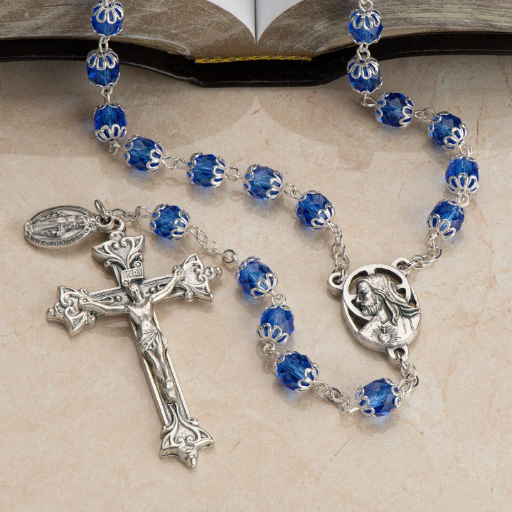
So, there exist great variations in rosaries, depending on the region and associated traditions and culture. In Catholic traditions, the typical rosary includes five decades, while the Eastern Orthodox prayer ropes commonly make use of knots rather than beads. Anglican beads, an even modern invention, are arranged in four groups of seven beads, each group pertaining to a special theme of prayer. In addition, local colors and materials tend to be used in places like Latin America and Africa. These types of variations testify to the fact that the rosaries are universally adaptable, while at the same time sending them to their central purpose of assisting in prayer and meditation.
Different Types of Rosary Beads
There are all kinds of rosary bead designs and forms to represent cultural, religious, and artistic traditions from across the globe. Some types of rosary beads and special features of each appear below:
Catholic Rosary Beads
Ideally, the Catholic Rosaries would be traditionally one of five decades composed of ten Hail Mary beads, separated by single Our Father beads. Ordinarily, a crucifix or religious medallion adorns its grouping. Some kinds of rosaries are meant to be meditated upon, each decade being dedicated to a mystery of faith.
Eastern Orthodox Prayer Ropes
In place of beads, Eastern Orthodox Christian practice considers its prayer ropes to be knotted strings. They commonly number 33, 50, or 100 knots, each recitation of which corresponds to the Jesus Prayer, “Lord Jesus Christ, Son of God, have mercy on me, a sinner.” These ropes sometimes also contain wooden or metal divider beads for convenience.
Anglican Rosaries
A slightly newer design, Anglican rosaries comprise four groups of seven beads, called weeks, separated by a transition bead. This structure encourages a flexible approach to meditation and prayer. Anglican prayer beads are made from all sorts of materials, including semi-precious stones and glass.
Chotki or Komboskini
A variation on the ropes of prayer, the Chotki or Komboskini applications of the Eastern Orthodox tradition often feature intricate hand-knit designs. This prayer apparatus may come in anywhere from 33 knots to 150 or more, crafted in a pattern having spiritual meaning.
Islamic Misbaha or Tasbih
While these are not technically rosary beads according to Christianity, the Misbaha or Tasbih consists of prayer beads used by Muslims for commemorations of Allah (dhikr). These beads generally come in counts of 33, 66, or 99, corresponding to the number of attributes of Allah.
Hindu and Buddhist Mala Beads
Traditionally for 108 beads, mala beads serve both for the praying and meditation of Hindus and Buddhists. Commonly from wood, seed, or stone gemstone compositions such as rudraksha or quartz, these beads are indispensable tools for concentration during mantra recitations.
Cultural Variation
Throughout Africa and Latin America, the making of rosary beads often involves bright, locally sourced materials such as seeds, clay, or colorful stones. These designs not only increase aesthetic appeal but also speak for themselves in terms of cultural identity and creative impulse. For example, seed rosaries in South America often combine spiritual symbolism with nature-based mastering.
Popular Rosary Materials and Options
Rosary beads are made from a variety of materials, each providing a different tactile and aesthetic appeal. The most commonly used are types of wood, glass, metallic alloys, and other gemstones such as amethyst or turquoise. Fine quality pearl and silver are usually favored for heirloom or ceremonial rosaries. In keeping with current trends emphasizing greener means, recycled glass and natural seeds have begun to become popular.
Current Trends in Rosary Design
Contemporary rosaries now admit options for both the traditionalist and the original design seekers, according to trend and by way of recent searches. The personalized rosaries that have options for customized engraving or birthstone beads on them are gaining popularity. Another favorite model selling a compact design is adjoined with being totally wearable: ring rosary and bracelet rosary; these styles are convenient for carrying and for daily use.
Today, the modern rosaries marry tradition with innovation and continue to be a favored instrument for prayer across generations and cultures. The presence of diverse types affirms their worldwide relevance and utmost significance.
Regional Variations in Rosary Practices
Rosary practices have their distinct variations from region to region. These variations come about due to different cultural, spiritual, and historical influences that have existed over time. For example, in Latin America, the rosary has strong ties to public worship and is often said in groups during Novenas or special occasions such as Día de los Muertos in Mexico. Here, the colors of the rosary beads might be loud and proud, or bear symbols that connect to a local form of religion, such as an image of the Virgin of Guadalupe.
On the other hand, countries of Europe like Italy or Poland tend to have a family tradition devoted to the recitation of the rosary, in particular on festive days such as Christmas and All Saints’ Day. There is also nary an event in Poland that does not involve rosary praying, including the Rosary to the Borders, a nationwide initiative for prayer aimed at fostering unity and faith.
In Southeast Asia, a Catholic-dominant country of the Philippines gives importance to Marian devotion, and the rosary finds practical use in daily prayers and also processions, the Flores de Mayo being the most popular. The rosary beads may be of native materials like wood or shell.
Most African countries add singing and dancing to their rosary prayers, creating an ambience of vibrant, rhythmic, and joyful expression of faith. The beads used in this part of the world are often brightly colored and elaborately designed, reflecting traditional African art.
These practices of rosary in different regions portray the cultural richness and flexibility of this method of devotion, showing its appeal on a universal canvas while also acknowledging community practices and expressions of faith.
Modern Adaptations of Traditional Rosary Beads
The world of today thus presents an interesting scenario unfolding in sculpting the designs of these traditional rosary beads. Any such mingling of old traditions with modern technologies is a crucial example. With the dawn of this technology, the digitalism and wearable rosaries began cropping up, namely the Vatican’s initiative with the “Click to Pray eRosary.” A beauty of the idea: it works as an actual prayer instrument and still has its digital footprint by way of smartphone apps that guide prayers, monitor prayer habits, and count down to encourage praying in this digital age.
Eco-friendly designs are an alternative one sees coming into its own, where rosary beads are prepared from sustainable resources: recycled wood, hemp, or even plant-based resins that biodegrade. This shows that believers are increasingly aware of the environment as a separate entity.
Global sales of rosary beads and related spiritual items have steadily increased, especially in North America and Europe, given some data and reports. The rise in the absorption of these products might have something to do with the comparatively newfound interest in mindfulness and spirituality among the lower age demographic. According to the latest market research, spiritual products, which include the modern rosary, have witnessed an increase in their sales at an approximate rate of 5% per annum over the last ten years.
These modernizations illustrate how the rosary continues to evolve with times, yet still maintain its stature as a significant spiritual instrument. And from being initiated through digital technology to go eco in design, undoubtedly, the various modern designs of rosary beads openly portray the capability of the faith community to innovate while still holding firm to tradition.
Reference Sources
- Marquette University: Rosary
Provides detailed information on the structural aspects and use of rosary beads in prayer.
- Elon University Catholic Campus Ministry: How to Recite the Holy Rosary
Explains the prayers said on each bead and lays out the general structure of the Rosary.
- Harvard Nieman Foundation: From Basketball Stardom to Rosary Beads
Talks about 59 beads in a rosary and their function in forming prayer repetition.
Frequently Asked Questions (FAQs)
How many beads are in a rosary?
A traditional Catholic rosary consists of 59 beads, which include 53 smaller beads used for reciting the “Hail Mary” and 6 larger beads for the “Our Father.” The rosary is structured in five decades, each containing a group of ten beads.
What is the meaning of rosary beads?
The rosary beads are used as a tool for prayer and meditation, helping individuals to focus on the mysteries of the life of Jesus and the Virgin Mary. Each bead represents a specific prayer, creating a rhythm that assists in the recitation of the prayers during the rosary.
How do you pray the rosary?
To pray the rosary, one begins with the crucifix, reciting the “Apostles’ Creed.” Following this, the first large bead is used for the “Our Father,” and then each of the ten smaller beads is used to recite a “Hail Mary.” This pattern continues for five decades while meditating on the mysteries of the rosary.
What are the mysteries of the rosary?
The mysteries of the rosary are significant events in the lives of Jesus and Mary, divided into four categories: Joyful, Sorrowful, Glorious, and Luminous. Each mystery is contemplated during the recitation of the rosary, enhancing the spiritual experience.
What is the significance of the colors of rosary beads?
The colors of rosary beads can hold different meanings, often representing various aspects of faith. For example, white may symbolize purity and the Virgin Mary, while green can represent hope. The choice of color may also reflect personal devotion or tradition.
Can anyone use rosary beads?
Yes, anyone can use rosary beads, regardless of their religious background. While they are primarily associated with Catholic tradition, many people find comfort and peace in using prayer beads for meditation and personal prayers.
How to make rosary beads?
To make rosary beads, you need a set of beads, a crucifix, and a string or wire to thread them onto. Begin by attaching the crucifix to the string, then add the beads in the traditional order, grouping them into sets of ten for the decades, and finishing with the larger beads for prayers.
What are Anglican prayer beads?
Anglican prayer beads are a form of prayer beads used in the Anglican tradition that differ from the Catholic rosary. They typically consist of 33 beads arranged in a circle, with a larger bead to signify the beginning of prayer and are used for various forms of meditation and prayer recitation.


